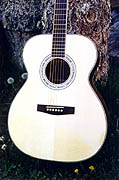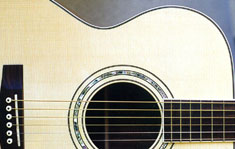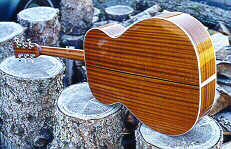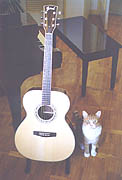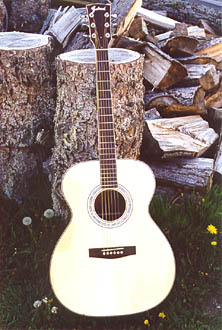
DESIGN AND CONSTRUCTION NOTES
As a luthier, one of my first tasks is to decide upon an instrument design.This means that I must imagine what the "voice" of the instrument will sound like, what kind of playing style it will be suited for etc. and work backwards from that. To do this,I have to decipher many interrelated parameters such as what materials to use. This can only be done with the experience of building with different "recipes" of wood and design.
The way that the parts are "tuned" combined with the technical skill to create perfect joints that last has a major influence on the final outcome. Then comes the search for the "perfect wood". As the traditional wood supply is often limited or rare, it becomes a difficult (but not impossible, just expensive) task to find the highest quality pieces.
This situation has led builders to try "alternative" woods with great success. What is needed here is the understanding of the properties of the wood and how it will react. But the actual piece of wood that is to be used will always dictate a part of the design and the luthier must be sensitive to these factors.
Now that the finest materials are selected, one of the more crucial factors is the state of their enviroment's temperature and humidity, and consequently the moisture content of the wood.I season my wood at 43-45% relative humidity and build at the same. Guitars are made of wood and wood is hygroscopic (continually taking on or giving up moisture depending on the environment). Even if the instrument is completly sealed with finish it still passes moisture (albeit more slowly). This is why it is critical for the wood pieces to all be completly acclimatized to the same relative humidity before they are glued together into a permanent relationship. A piece that has more moisture content than one that it gets glued to will shrink with disastrous results.
The moisture content of an instrument made of wood should be of constant concern throughout it's lifespan. It's easier now than ever for the guitar owner to control the guitar's environment with the aid of accurate and inexpensive digital hygrometers and humidifying gadgets.
As for building technique, I always strive for precision and perfection! For example, I will use a hand tool instead of a machine if I think the result will benefit...no matter how much more time consuming. Besides, there's something intensley satisfying about the whistle of a perfectly tuned and sharpened hand plane curling out a long unbroken shaving!
For those that are interested, I will list some of my procedural details:
- for critical joints such as the soundboard center-seam and the back center-seam, I never use an electric planer. Many manufacturers use an electric planer just because it saves so much time;
I'm talking about perhaps 30 seconds for the electric method as compared to almost an hour by hand! I use a hand plane to "shoot" the joint. The main difference is in the cutting action, the hand plane will take one continuous cut leaving a perfectly flat plane on the freshly cut edge.
The electric planer uses a rotary cutter which takes a tiny "scallop" out of the edge (these scallops become more pronounced with a faster rate of feed). Another artifact of the electric planer is that as the cutter comes around to the wood it also slightly compresses and "burnishes" the wood fibres, especially if the knives are not dead sharp.
The next step in this process is to fit both halves of the freshly planed wood together. When held up against a strong light, even the slightest opening in the joint will reveal itself with a blazing sliver of light! This is called "candling". I'm not exactly sure of what the numerical tolerance for such a joint would be, but I know that even .001" (which is basically my smallest measurable tolerance for any other operation in guitar making) is way to big and produces a huge shaft of light!
I have been using carbon fibre to re-enforce necks for years now and I absolutley love it! The tone is more even (less dead spots) and the tuning is much more stable. The neck will also hold a fine set-up longer because of it's stability.
Other candidates for carbon fibre re-enforcement are the soundboard braces.In a nutshell, the luthier tries to make the soundboard as light and responsive as possible tempered only by structural consideration- make it too light and it will fail (break, buckle, distort etc.).
By conducting beam deflection experiments on normal soundboard braces, I found that if I laminated a .020" thick piece of carbon fibre into the middle of a brace, it could be made about 25% lighter while retaining the same deflection figures. This is an ENORMOUS reduction! Well it looked great on paper, but I had some concerns. What would it sound like? Are there any unforseen side effects? Why aren't more manufacturers doing this? Here's what I determined:
What does it sound like?
Because the carbon fibre allows me to build the soundboard assembly much lighter, the dynamic response is astounding! The voice becomes much more responsive to the touch, transient attack is much quicker (sparkling attack), low frequency response is far more extended and generally fuller. Most impressive however is that the sound is so much bigger and more open! The harder you play, the louder it gets without choking. So to sum up sonically, it's louder, more powerful, more sensitive dynamically, more open.
Unforseen side effects:
My concern was mainly that since the use of carbon fibre is relatively new to guitar making, how would it stand up to the stresses of everyday playing and vibrations? Or of humidity's effect on the wood that it is glued to? My answer came after years of observation and and I'm happy to say that everything looks great! Absoltuly no degredation, no signs of delamination and joints are solid and tight.
Why aren't more manufacturers using carbon fibre?
- carbon fibre is expensive
- it cannot be cut with any traditional edge tools (planes, chisels etc.). This makes shaping braces a very difficult and time consuming task
I always choose the neck material very carefully because it has been my experience that not only does it influence the sound of the instrument, but it can also affect the stability of the neck and the set-up. I almost always use quartersawn wood for both the neck and fingerboard.The term "quartersawn" refers to the angle of the grain orientation of a particular piece of wood. It is the best (and most expensive) way to cut the material for most instruments. My selection criteria also includes specific gravity, tap-tone testing, straightness and width of grain, stiffness and also how long it's been seasoned. This is pretty much my criteria for selecting any piece of wood.
All throughout the building process, from rough sawn lumber to a finished piece, I continually test for tap-tone. (I think the lumberyards all have a laugh at the guy (me) who comes in and taps and listens to every piece of wood that he picks up! haha)
The mechanics of how a guitar plays...how it feels can really make or break it! Things like the shape of the neck, the radius of the fingerboard, the size of fret wire and how the frets are installed and dressed, the action and intonation all play a major role. A bad set-up on a good guitar can render it "useless" or no fun to play at all. Over the years, I have done thousands of set-ups and re-frets etc. and I know what the importance of a first class set-up is. A sensitive musician can detect the smallest detail in the feel of an instrument. My goal is always to make the guitar feel so right that the mechanics are forgotten and the musician can simply play with natural expression.
Prices start at $3,500.....to order yours click here!
Freddy
Home
